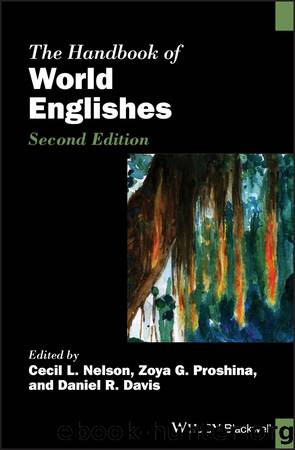The Handbook of World Englishes by unknow

Author:unknow
Language: eng
Format: epub
ISBN: 9781119147275
Publisher: Wiley
Published: 2019-10-01T00:00:00+00:00
In order to sustain the impression of the shift from English to Igbo, queshon becomes questions.
While we are concerned here with creativity in English, it should be noted that the problems are equally present for those who use âindigenousâ languages such as Tagalog, Bengali, and Malay, or other migrant languages, of which Tamil and Mandarin in Singapore and Malaysia would be instances. The human situation is complicated by biâ and trilingual, polydialectal factors, not so much for the individual participants as for those who wish to grasp the whole. The writer is concerned to articulate his interest, his vision, and the themes ensuing therefrom. When he reads contemporaries and predecessors, whether in the original or in translation, his motives differ from those of a critic; it is part instruction, part nourishment. If he essays criticism, the practice is informed by writerly insights. The frame of reference for the critic is significantly broader, for while he may be engaged with a particular text or writer, his very role implies a concern with a literature or literatures. He is concerned, in varying degrees, with periods, with movements, with judging writers, preferring one to another and providing grounds for his preferences. His view combines a sense of the contemporary and a sense of the past, the writer with the production of the literature. The writer installs his vision in his work; the critic considers this vision as well as that of other writers. In the context of African literatures in English, it means no less than finding a frame for discussing and evaluating the works of, say, Kofi Awoonor, Chinua Achebe, Gabriel Okara, Elechi Amadi, NguÍgÄ© wa Thiongâo, and Oko pâBitek. Extend the list to include the Anglophone writers in Heinemannâs African Writers series â then Indian, West Indian, Southeast Asian, and South Pacific literatures in English, not to mention their links with âindigenousâ literary traditions â and you have a fair conception of the critical tasks. For each writer there is perception and performance, active and passive stance ranging from a feel for the larger political and social realities to the specifics of individual thought and feeling.
Criticism is simultaneously a generalizing and a specifying activity. There is the tempting assumption that a work is to some degree characteristic, that its distinctiveness can be accounted for within the prevailing semiotic systems. Moreover, a work that demonstrably cuts against the grain, however powerfully disturbing (Joyceâs Ulysses is an obvious example), can be accommodated; it does not bring in the context of another linguisticâliterary semiotic system. The literature and its language continue to change through revolution and evolution. Donne, Dryden, Fielding, Wordsworth, Eliot, Joyce, and Yeats were innovators, major figures who opened up new possibilities of language and structure that influenced their contemporaries. Thus the revolution settles down to an evolution, establishing a mode, a period. It makes for a degree of acceptable generalization in which the discussion of text or issue has force beyond the specific occasion. Instances are the metaphysical conceit or the theory and practice of Augustan poetic diction.
Download
This site does not store any files on its server. We only index and link to content provided by other sites. Please contact the content providers to delete copyright contents if any and email us, we'll remove relevant links or contents immediately.
Goodbye Paradise(3652)
Atlas Obscura by Joshua Foer(2749)
Tokyo by Rob Goss(2338)
Lonely Planet New York City by Lonely Planet(2132)
Borders by unknow(2132)
DK Eyewitness Top 10 Travel Guides Orlando by DK(2071)
Top 10 Dubai and Abu Dhabi by DK Travel(2026)
Tomb of the Panzerwaffe: The Defeat of the Sixth SS Panzer Army in Hungary 1945 by Aleksei Isaev & Maksim Kolomiets(1804)
Rick Steves London 2018 by Rick Steves & Gene Openshaw(1785)
Dirt by Bill Buford(1570)
The Path Between the Seas by David McCullough(1531)
Atlas of Improbable Places by Travis Elborough(1465)
the fault in our stars by john green(1446)
The Travels by Marco Polo(1405)
Tokyo on Foot by Florent Chavouet(1395)
Need by Unknown(1392)
The Lives of Conn Smythe by Kelly McParland(1368)
The Lord of the Rings: The Fellowship of the Ring, the Two Towers, the Return of the King by J. R. R. Tolkien(1334)
Still Alice by Lisa Genova(1332)
